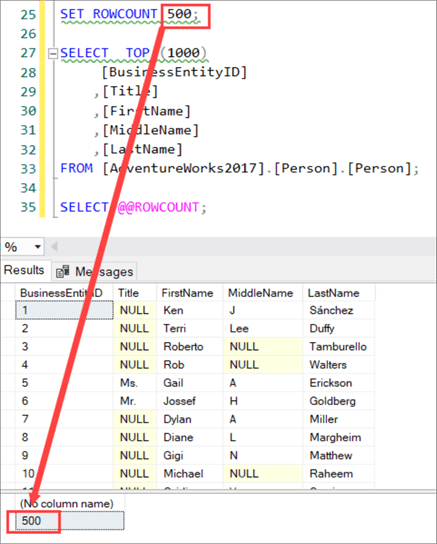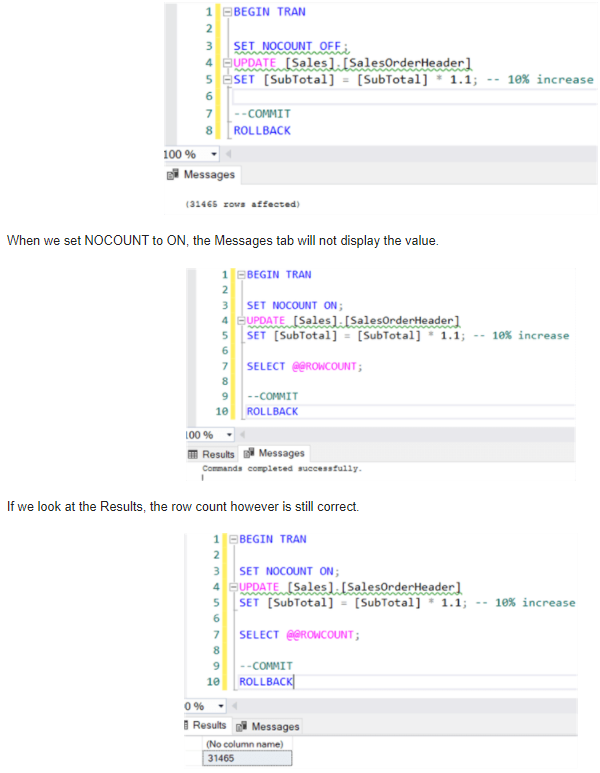How to Use Rowcount in Sql Server
Link
How to use @@ROWCOUNT in SQL Server
https://www.mssqltips.com/sqlservertip/6091/how-to-use-rowcount-in-sql-server/
Usage
SELECT @@ROWCOUNT in the same execution block to get the result back
SELECT TOP 1000 * FROM dbo.Customer;
SELECT @@ROWCOUNT;
This returns the query results and the count of how many rows from that result set
SELECT @@ROWCOUNT;
executed by itself only returns a count of 1 record (itself).
Error Handling and Business Rules
Using SQL Server
@@ROWCOUNTfor Error Handling and Checking a Business Rule
BEGIN TRAN
UPDATE [Sales].[SalesOrderHeader]
SET [SubTotal] = [SubTotal] * 1.1; -- 10% increase
IF @@ROWCOUNT = 0
PRINT 'Something went wrong!'
ELSE PRINT 'Rows were updated...'
--COMMIT
ROLLBACK
Instances of Large ROWCOUNT
SQL Server ROWCOUNT_BIG function
The data type of @@ROWCOUNT is integer. In the cases where a higher number of rows are affected than an integer can handle (meaning more than 2,147,483,647 rows!), you need to use the ROWCOUNT_BIG function. This function returns the data type bigint.
SELECT TOP 1000 * FROM dbo.Customer;
SELECT ROWCOUNT_BIG();
Utilizing ROWCOUNT with Try Catch Statements
BEGIN TRY
SELECT TOP 100 * FROM [AdventureWorks2017].[Person].[Person];
END TRY
BEGIN CATCH
SELECT TOP 50 * FROM [AdventureWorks2017].[Person].[Person];
END CATCH
SELECT @@ROWCOUNT;
/*
@@ROWCOUNT returns zero! This is because the last statement is not the SELECT statement from the TRY block (which has been executed), it’s also not the one from the TRY block as it’s the last SELECT in the script. It’s the TRY/CATCH block itself! @@ROWCOUNT returns the affected rows from any statement, even if it’s not DML or a SELECT query.
To avoid this kind of scenario, you can store the row count in a local variable. The script would then look like this:
*/
DECLARE @rowcount INT;
BEGIN TRY
SELECT TOP 100 * FROM [AdventureWorks2017].[Person].[Person];
SET @rowcount = @@ROWCOUNT;
END TRY
BEGIN CATCH
SELECT TOP 50 * FROM [AdventureWorks2017].[Person].[Person];
SET @rowcount = @@ROWCOUNT;
END CATCH
SELECT @rowcount;
SQL Server SET NOCOUNT AND SET ROWCOUNT
SET ROWCOUNT
Although the name, SET ROWCOUNT is very similar, it doesn’t impact @@ROWCOUNT directly. SET ROWCOUNT simply tells SQL Server to stop processing a query after the specified number of rows have been returned, which makes it kind of a “global TOP clause”.
In the following example, we’re limiting the rows to 500. The SELECT query itself should return 1,000 rows, but as you can see @@ROWCOUNT tells us only 500 were returned.

SET NOCOUNT
SET NOCOUNT ON also doesn’t affect @@ROWCOUNT. SET NOCOUNT tells SQL Server to stop displaying the message with the number of rows affected by a query. However, @@ROWCOUNT is still updated.
Let’s illustrate with an example. First the default configuration where NOCOUNT is off.

Backlinks